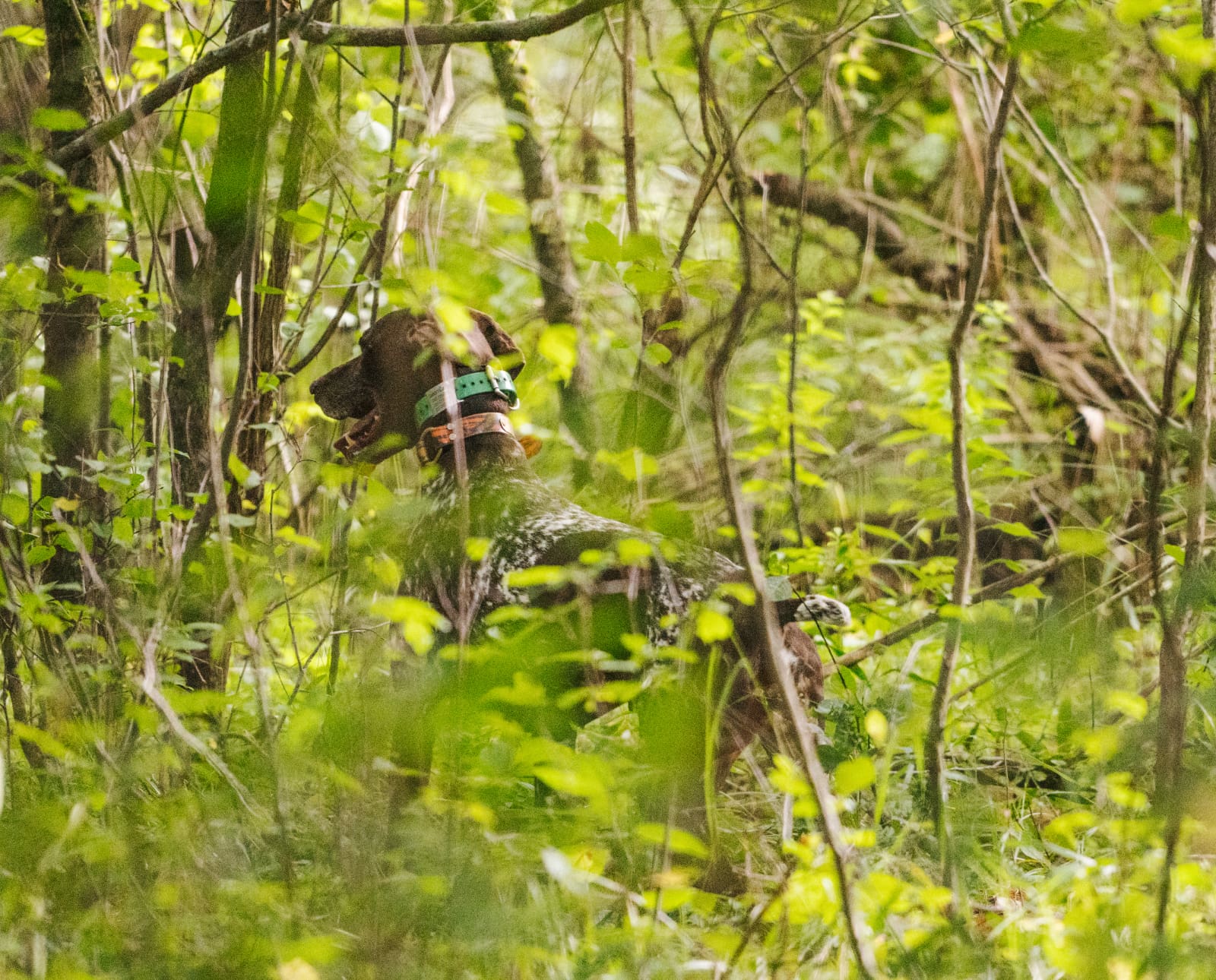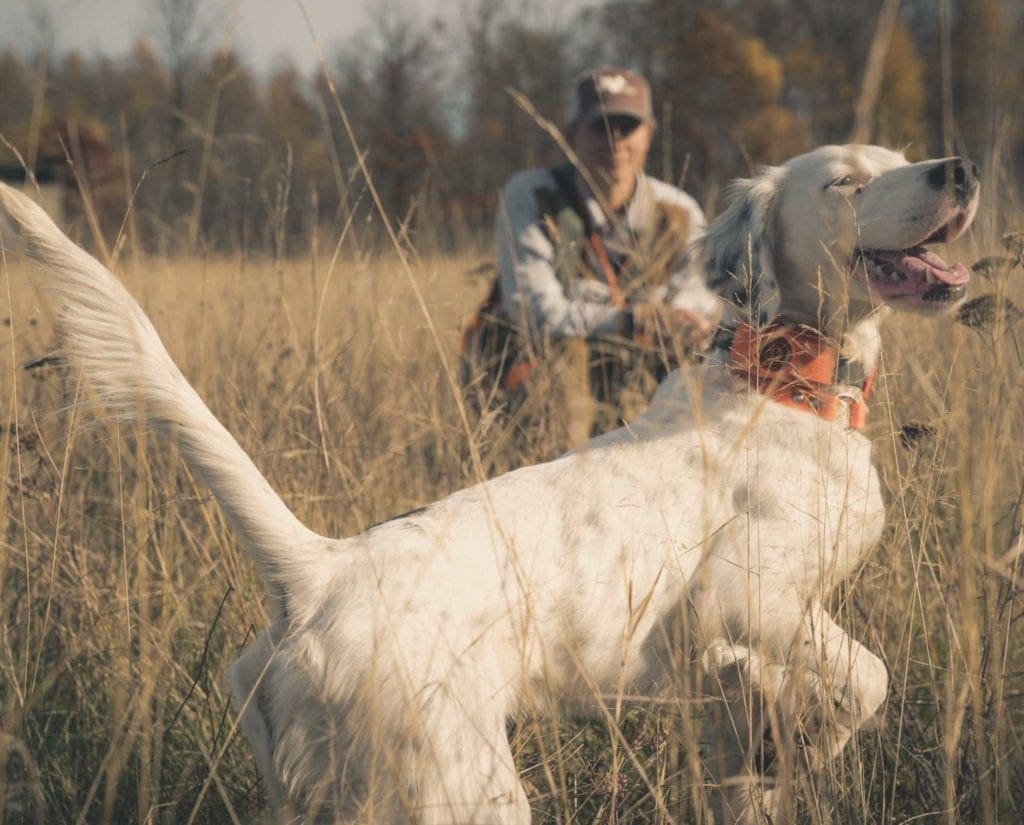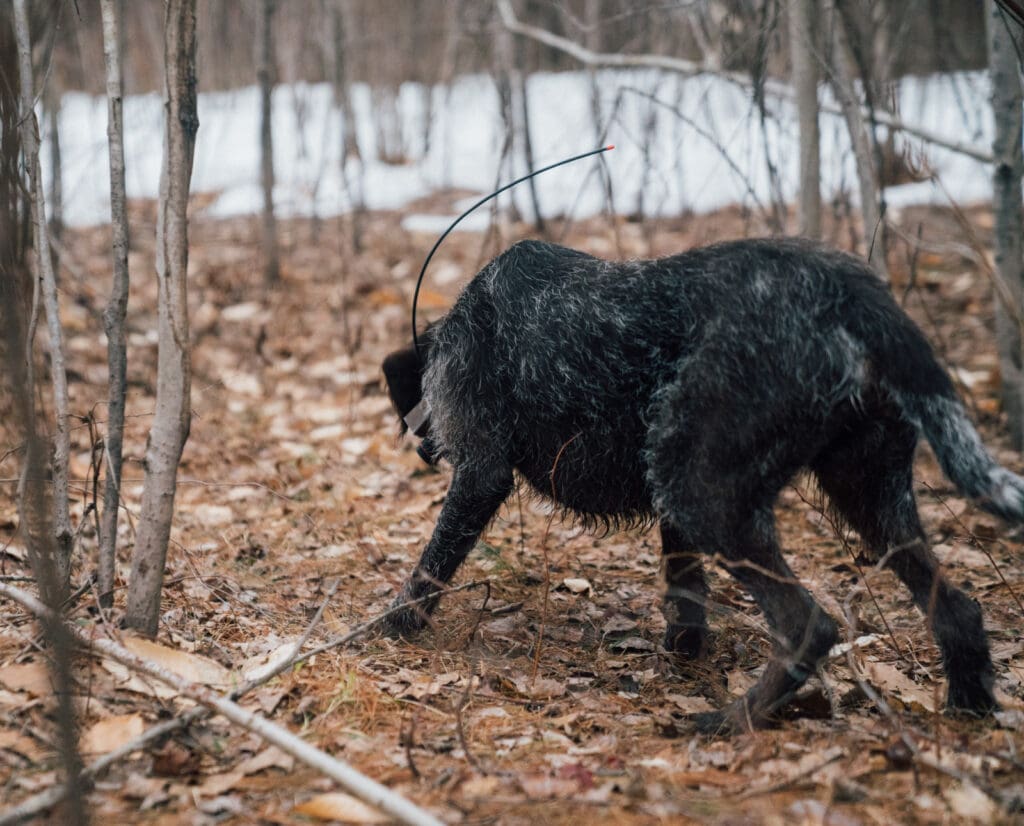Home » Hunting Dogs » Understanding Flagging in a Bird Dog
Understanding Flagging in a Bird Dog

Jason Carter is a NAVHDA judge, NADKC member, director of…
Flagging in a bird dog can be prevented and fixed with proper training
So what if my dog has a wiggle butt and flags a bit on point? It’s kinda cute and still gets meat to the frying pan. If that’s the case and your dog will efficiently hunt, locate plenty of birds for you and stand point, I would happily agree with you. More often than not, however, it will affect your hunt in some aspect as it’s a symptom of underlying holes in your bird dog training. It could develop into, amongst other things, a restrictive search, blinked retrieves, self hunting, ripping birds, stealing points and retrieves—which not only limits productivity in the field, it guarantees relentless ribbing from your hunting buddies.
Listen to more articles on Apple | Google | Spotify | Audible
In my last Project Upland article, we discussed some of the nuances of reading your bird dog’s body language and figuring out what they are trying to tell you. I referenced flagging as a specific undesirable action in a pointing dog. Let’s delve into that a little bit deeper to gain some understanding.
What is flagging in a bird dog?
Flagging is the behavior of wagging the back end when the dog is in the presence of game. As we discussed in the previous article, the tail can be a deceptive little bugger to figure out. Getting to the root of why your dog flags on point can be a real head scratcher. To sort out the driving factors behind the flagging, you need to look at their mental state.
As described in the NAVHDA AIMS book, a strong pointing dog should have an intense, convincing, unmistakable and in the end productive point. Believe me when I tell you, watching a dog backslide from that rock solid iconic pointing dog to a soft, loose flagger can be soul sucking. Though somewhat depressing, flagging for most is not a life sentence. It’s rather a temporary behavior that may pop up here and there in your training, letting you know you missed something and need to take a step back.

Reasons a bird dog is flagging
The reasons behind the flagging generally fall within two categories. One, the dog is foundationally immature or deficient in its training. It is lacking in the necessary drive and understanding to enthusiastically seek out and pursue game. Two, the dog is over driven, out of balance and incapable of controlling its emotions. It lacks the training and/or the mental stability around game to hold point.
Bird dogs that lack drive
For those lacking in drive, you may see the flagging start while the dog curiously and/or nervously approaches or circles a bird. It attempts to get as close as possible to the bird, though fears making contact. Normally, the strong scent triggers an automated response to freeze. However, for those dogs with poor pointing instincts and low drive, flagging will be the common symptom as it stands the point.
This can be seen in young pups who were improperly introduced to birds and steadiness before they were ready. Be sure to take every precaution to avoid imprinting pups to believe that birds are connected to negative experiences. When an underdeveloped dog is over pressured, at best, it may begin to flag, or worse it learns to blink the bird (i.e., leave the bird). Flagging may also be created through over training with too many birds, causing your dog to become bored of the repetitive canned scenarios. If possible, plan on sprinkling in a fair amount of training on wild game. It will proof your steadiness, infuse excitement back into your dog’s training and prevent flagging.
I also would be remiss not to address the underlying genetic makeup of your dog. Let’s face it: not every gun dog has what it takes. Each pup comes to you with a predisposition and foundational package from your breeder. It’s within those traits that we rely heavily in developing our pointing dog. Without a strong prey drive and the instinct to point, the best we can do is get our dogs to stand point, which will likely appear very loose and soft, with a fair amount of flagging.
Not that I want to get all doom and gloom on you—it’s just something to be aware of. Be sure to take your time, be fair, have realistic expectations and let the dog dictate when it’s ready. The key is understanding that pointing is drive dependent. Through the pursuit of game, the drive within the dog builds and the pointing instincts are brought to surface. In time, the pointing strengthens and the potential for flagging dissipates.

Overdriven bird dogs
Now for those dogs that are overdriven, out of balance and lacking control over their own emotions. The underlying drive issues in your dog causing the flagging is stimulated in a number of ways. It could be that its retrieving drive is overpowering the pointing or that the dog is so out of control and disobedient that the handler’s commands become irrelevant.
This often occurs when folks rush their dog towards the finish line and neglect to properly chain their training lessons together in a manner that leads their dog towards steadiness success. Ideally, you want the strength of your obedience to be strong enough to balance out and settle your dog’s emotions around the game. Instead, handlers often skip steps and their dog defaults back towards the predatory instincts of chasing and catching. It’s paramount not to jump ahead and to be thorough in your training.
Handlers can be their own worst enemy at times, placing fault onto their dog, not understanding that their dog is the product of their own training program. Through slowing down and developing a strong obedience foundation, you can create that focused partnership that can handle high drive situations, particularly around steadiness. Whether it be on dog lead, on tethered game, within distraction or on a whistle, the whoa should be nearly bomb proof. A dog that understands that it has to remain still will have a settled mind which discourages flagging.
It’s only then you can develop that stable working relationship that is required around liberated birds. It’s the cornerstone of preventing high drive flagging. Without it, the over excitedness remains and the dog will likely lose trust in you; it will become passively disobedient and develop the tendency to flag. Though it may stand point as commanded, it will continue to exhibit the flagging behavior as the handler hasn’t cured the dog’s underlying desire to take out the bird and be selfishly disobedient.
Your only choice will be to back up your training and fill the holes in its obedience and steadiness. Only after extensive remedial work can you reintroduce the dog back into the field. Fortunately, dogs generally are somewhat forgiving of our mistakes as they want to please.
Flagging is relatively easy to avoid as long as you remain a fair and patient handler who progresses at a pace set by the dog. With a stable temperament and copious amounts of thoughtful developmental training, you can fulfill your hunting dog’s destiny of becoming that picturesque hunting machine you always knew they’d become. One where every molecule of the dog screams bird here, resonating to your core as hunter and as a trainer.
Jason Carter is a NAVHDA judge, NADKC member, director of youth development, secretary of NAVHDA’s youth committee, clinic leader and trainer at Merrymeeting Kennels. He has been around versatile hunting dogs his entire life, literally! Born into the Carter family and Merrymeeting Kennels, he attended his first NAVHDA test in Bowdoinham, Maine, when he was just a year of age. Jason successfully trains, tests and breeds Deutsch Kurzhaars in both the NAVHDA and NADKC testing systems. Through his work at the kennel, Jason has had the opportunity to develop pointers, flushers and retrievers over the years. When October arrives he can be found with family and friends hunting throughout New England.




I believe I have a different reason my dog flags. It appears to me she gets wind of the bird and either the scent changes direction or she is pointing far off and the scent is faint. Once I give her the command to relocate she will move up and then lock up like a statue. This happens about 50% of the time. How do I get her to trust her nose and lock up further back initially or when the scent cone shifts? Note this is generally only an issue on pen raised birds, but those are what we use in field trials when I want her looking her best.
Going from what your telling me, you are allowing her the opportunity to crowd the bird causing the issue. Instead, pop the bird from a remote trap and shoot it if it’s a trust issue. Or stand back and give it some time to make the decision to creep if it’s a take out issue. Take your time in this situation. Don’t feel you need to rush or insert yourself and the dog will likely reveal its intentions. Popping the bird on that first step will teach it that the creeping or self relocation caused the bird to get away. Wild birds don’t let her get away with it, why should we? If she is pointing and flagging on the fringe of scent, teach the dog to trust by popping and shooting the bird. It’s likely the dog is sure of the bird’s location. Also, simply allowing the bird to fly away as it establishes point can send a powerful message to the dog. This will make the dog more cautious and likely more intense in it’s pointing. I know it’s tough seeing that ten dollar bill fly away, though it pays for itself back in pointing intensity. This is one of many ways to handle this situation. Hope this helps.
my 5-year-old pointer has a similar problem to Matthew’s dog – handles wild birds almost perfectly, next best on liberated birds – on hard-planted competition birds, he’s more likely to either blink, flag till it flushes, or flag till he’s convinced it’s down and out, then pick it up and bring it to me, often from a great distance – means we can’t train on pen-raised birds, nor run in competitions – so what ? saves a lot in HT entry fees and he’s still a damned good hunting dog – but, brings me a lot of cripples, when hunting a release site – I take them (conservation of game), but that’s one less bird I get to work him on – tight limits here – anyway, he’s well disciplined and you mention discipline a lot, but I am starting to think ‘discipline’ is over-rated – you must know of Brad Higgins and his approach, he sums it up here: https://www.youtube.com/watch?v=aZngucPOQ4Q&t=325s
In the context of NAVDA testing flagging is undesirable. My take on the whole NAVDA approach is the use of planted birds and overtraining.
I have hunted AFSTB registered English setters since 1979. I have hunted with dogs that never were exposed to planted game and were dead broke to wing and shot. All done on wild game to include woodcock. Even completely broke wild bird dogs will occasionally flag…..the good ones will move on and relocate…..the scent cone can do funny things…..we (humans) don’t know what they smell like. My current dog from Jerry Kolter’s kennel is very definitive when hitting scent not too close just right until the bird(grouse) starts to run. She will flag occasionally when the scenting conditions are not right. I consider flagging one of many clues you can read from a dogs body language.
I have worked dogs with our local NAVDA chapter…pigeons in remote releasers…I avoid chuckars like the plague. Nothing good about them. It doesn’t take long for the dog to get training field smart and show perfect manners. In have rarely seen dogs flag in the planted game training field setting. Puppies from time to time..
My takeaway is if you want a good solid bird dog…minimize the use of planted birds….move on to a Johnny house and from there get them into the woods.
Wild bird exposure makes the dog,,